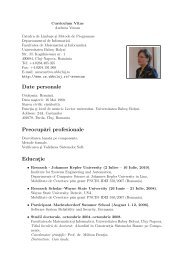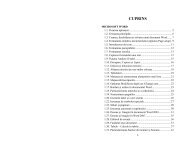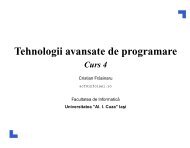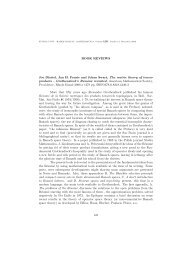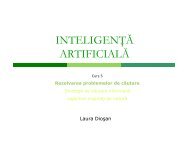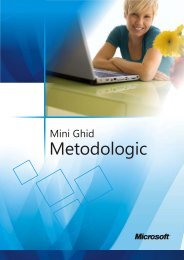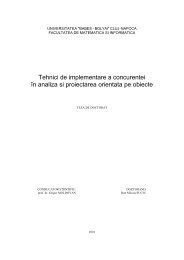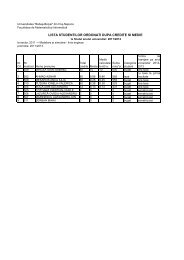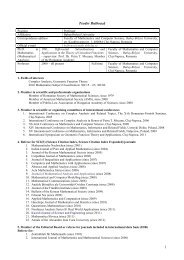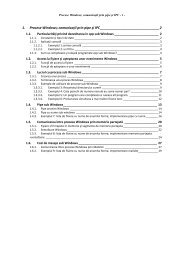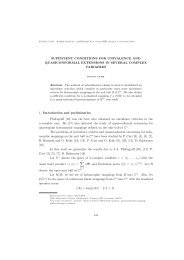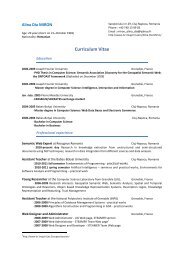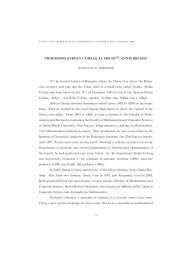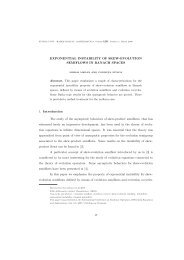CONTENTS
CONTENTS
CONTENTS
You also want an ePaper? Increase the reach of your titles
YUMPU automatically turns print PDFs into web optimized ePapers that Google loves.
THE MULTI-OBJECTIVE REFACTORING SELECTION PROBLEM 251<br />
MAX minus the real cost, where MAX is the biggest possible cost and the real cost<br />
values being less than MAX . Thus, the new function obtained by aggregating the<br />
two objectives can be written as: F (x) = α · f1(x) + (1 − α) · f2(x), α ∈ [0, 1] .<br />
The goal is to identify those solutions that compromise the refactorings costs<br />
and the overall impact on transformed entities. The decision vector → r = (r1, . . . , rm),<br />
ri ∈ SR, 1 ≤ i ≤ m determines the refactorings that may by applied in order to<br />
transform the considered set of software entities SE . The item ri on the i-th position<br />
of the solution vector represents the refactoring that may be applied to the i-th<br />
software entity from SE , where ei ∈ SEri, 1 ≤ i ≤ m .<br />
The algorithm proposed was applied on a simplified version of the Local Area<br />
Network (LAN) simulation source code that was presented in [1]. It contains 5 classes<br />
with 5 attributes and 13 methods, constructors included. The current version of the<br />
source code lacks of hiding information for attributes since they are directly accessed<br />
by clients. The abstraction level and clarity may be increased by creating a new<br />
superclass for PrintServer and FileServer classes, and populate it by moving up<br />
methods in the class hierarchy.<br />
Thus, for the studied problem the software entity set is defined as: SE =<br />
{c1, ..., c5, a1, ..., a5, m1, ..., m13} . The chosen refactorings that may be applied<br />
are: renameMethod, extractSuperClass, pullUpMethod, moveMethod, encapsulateField,<br />
addParameter, denoted by the set SR = {r1, . . . , r6} in the following. The<br />
dependency relationship between refactorings is defined as {(r1, r3) = B, (r1, r6) =<br />
AA, (r2, r3) = B, (r3, r1) = A, (r6, r1) = AB, (r3, r2) = A, (r1, r1) = N, (r2, r2) =<br />
N, (r3, r3) = N, (r4, r4) = N, (r5, r5) = N, (r6, r6) = N}.<br />
The values of the final effect were computed for each refactoring, but using the<br />
weight for each existing and possible affected software entity, as it was defined in<br />
Section 2. Therefore, the values of the res function for each refactoring are: 0.4, 0.49,<br />
0.63, 0.56, 0.8, 0.2.<br />
Here, the cost mapping rc is computed as the number of the needed transformations,<br />
so related entities may have different costs for the same refactoring. Each<br />
software entity has a weight within the entire system, but 23<br />
i=1 wi = 1 . For effect<br />
mapping, values were considered to be numerical data, denoting estimated impact of<br />
refactoring applying. Due to the space limitation, intermediate data for these mappings<br />
was not included. An acceptable solution denotes lower costs and higher effects<br />
on transformed entities both objectives being satisfied.<br />
The parameters used by the evolutionary approach are as follows: mutation probability<br />
0.7 and crossover probability 0.7. Different number of generations and of<br />
individuals are used: number of generations 10, 50, 100, and 200, and number of<br />
individuals 20, 100, 200. Current paper studies the aggregated fitness function where<br />
objectives have equal weights, i.e., α = 0.5.<br />
3.1. Results obtained by the Evolutionary approach. In order to compare data<br />
having different domain values the normalization is applied firstly. We have used two<br />
methods to normalize the data: decimal scaling for the rc function and min-max<br />
normalization for the value of the res function. The algorithm was run 100 times<br />
and the best, worse and average fitness values were recorded. Figure 1(a) presents



